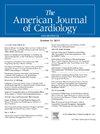Risk of Stroke and Incident Atrial Fibrillation in Patients in Sinus Rhythm With Nonischemic Dilated Cardiomyopathy
IF 2.1
3区 医学
Q2 CARDIAC & CARDIOVASCULAR SYSTEMS
引用次数: 0
Abstract
Nonischemic dilated cardiomyopathy (NIDCM) is associated with an increased risk of atrial fibrillation (AF) and stroke, especially in patients with high CHA2DS2-VASc. We aimed to identify variables associated with incident AF or stroke using left atrial deformation analysis and its prognostic value added to CHA2DS2-VASc score. Patients with NIDCM and left ventricular ejection fraction <50% in sinus rhythm were included between January 2015 and December 2019. Left atrial volume index (LAVI) and atrial strain were used in combination with the CHA2DS2-VAS score to predict ischemic stroke or incident AF. Proportional hazards Cox regression was used to provide hazard ratios (HRs). There were 338 patients included. After a median follow-up of 3.6 years, the end point occurred in 41 patients (12.1%). LAVI outperformed other echocardiographic parameters, with a significant improvement in risk reclassification compared with CHA2DS2-VASc alone (net reclassification index 0.6, increase in Harrell's C from 0.63 to 0.73, p = 0.003), and remained significant after multivariate adjustment. LAVI was associated with both components of the end point separately. The best cutoff for LAVI was 44 ml/m2. LAVI ≥44 ml/m2 increased the risk of the end point among those with CHA2DS2-VASc ≥3 (HR 6.0, 95% confidence interval 2.6 to 13.5) but not in those with CHA2DS2-VASc <3 (HR 1.2, 95% confidence interval 0.3 to 4.5). Competing risk analysis did not alter the results. In conclusion, LAVI might be used to assess the risk of incident AF or stroke in NIDCM. Patients with LAVI ≥44 ml/m2 and CHA2DS2-VASc ≥3 could be at high risk of AF and stroke and may benefit from more intensive surveillance.
非缺血性扩张型心肌病窦性心律患者发生中风和心房颤动的风险。
背景:非缺血性扩张型心肌病(NIDCM)与心房颤动(AF)和中风的风险增加有关,尤其是在 CHA2DS2-VASc 较高的患者中。我们的目的是利用左心房(LA)变形分析确定与房颤或中风事件相关的变量,并将其预后价值添加到 CHA2DS2-VASc 评分中。用 NIDCM 患者和 LVEF 2DS2-VAS 评分预测缺血性中风或心房颤动事件。采用比例危害 Cox 回归提供危险比 (HR)。共纳入 338 名患者。中位随访 3.6 年后,41 例(12.1%)患者出现终点。LAVI 优于其他超声心动图参数,与单用 CHA2DS2-VASc 相比,LAVI 在风险再分类方面有显著改善(净再分类指数为 0.6,Harrell's C 从 0.63 升至 0.73,P=0.003),经多变量调整后仍有显著改善。LAVI 分别与终点的两个组成部分相关。LAVI 的最佳临界值为 44 毫升/平方米。LAVI≥44ml/m2 会增加 CHA2DS2-VASc≥3 者的终点风险(HR=6.0,95%CI 2.6-13.5),但不会增加 CHA2DS2-VASc 2DS2-VASc≥3 者的终点风险。
本文章由计算机程序翻译,如有差异,请以英文原文为准。
求助全文
约1分钟内获得全文
求助全文
来源期刊

American Journal of Cardiology
医学-心血管系统
CiteScore
4.00
自引率
3.60%
发文量
698
审稿时长
33 days
期刊介绍:
Published 24 times a year, The American Journal of Cardiology® is an independent journal designed for cardiovascular disease specialists and internists with a subspecialty in cardiology throughout the world. AJC is an independent, scientific, peer-reviewed journal of original articles that focus on the practical, clinical approach to the diagnosis and treatment of cardiovascular disease. AJC has one of the fastest acceptance to publication times in Cardiology. Features report on systemic hypertension, methodology, drugs, pacing, arrhythmia, preventive cardiology, congestive heart failure, valvular heart disease, congenital heart disease, and cardiomyopathy. Also included are editorials, readers'' comments, and symposia.
 求助内容:
求助内容: 应助结果提醒方式:
应助结果提醒方式:


